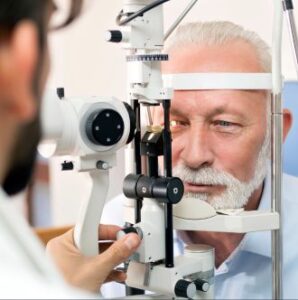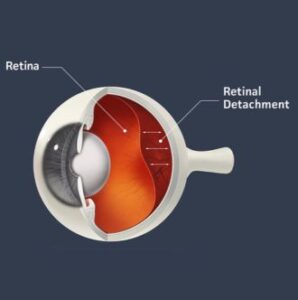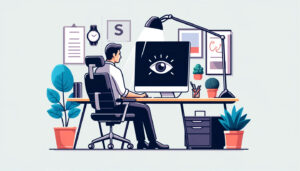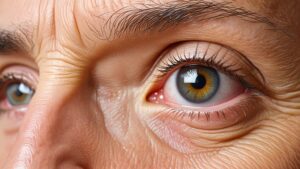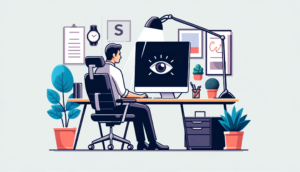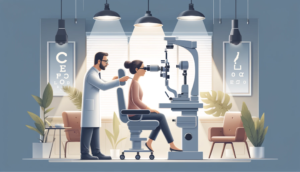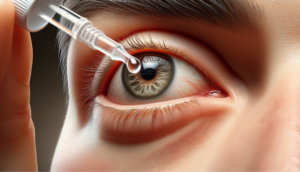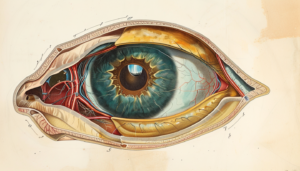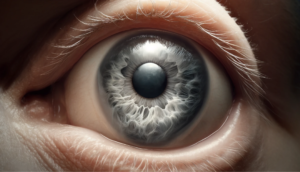If someone is able to clearly see objects that are close to them, but struggle to see objects in the distance, they may have myopia. Myopia is also commonly referred to as “nearsightedness”, because people with myopia generally are able to see objects better at near distances (e.g., when the object is closer to the person) than they do with objects far away. (The opposite of myopia is hyperopia, meaning that objects in the distance are clearer, often termed “farsightedness.”)
Myopia is not an eye disease, but rather a common vision condition, a type of refractive error that can develop in early childhood and may progress throughout someone’s life. Refractive errors are the different conditions that can alter the way that the structures of the eye refract (or bend) the light rays that reach the retina at the back of the eye. In order for a person to have sharp vision, light rays from the outside world need to be focused on the macula (the back part of the retina).
What are common symptoms of Myopia?
Many people with myopia can have difficulty clearly seeing objects at a distance. They may complain that things appear hazy or blurry or that they have difficulty seeing things on a board at the front of a classroom, or signs along the road, while books or objects up close are easier to see clearly. Some people find that they notice blurred or poor vision more so at night (night myopia). They may often squint (e.g., strain their eyes and furrow their brow) to try to see things better.
Often, myopia begins to develop in childhood, and it can be difficult for children to recognize or communicate problems they may have with their vision. Therefore, it is recommended that children be examined by an optometrist or ophthalmologist before they begin school to correct and avoid any potential problems with vision before they negatively affect learning. Parents or caregivers of children may notice that children with myopia may squint and/or blink a lot, sit closer to the television, or frequently rub their eyes. If a significant amount of myopia is not detected early in children, it can sometimes lead to amblyopia, where one eye is preferred more than the other and the visual pathways of the poorer seeing eye are permanently damaged.
Myopia symptoms may develop very gradually and be difficult to detect. Some people do not realize that they are squinting or straining to see, and this can lead to symptoms that are not related to vision. These may include eye strain, frequent blinking, headaches or pain in the neck, shoulders or upper back.
How is Myopia diagnosed?
Myopia can be detected during a regular eye examination. The examination usually begins with testing visual acuity by reading letters on an eye chart to determine how clear vision is at different distances. Visual acuity is normally described in a Snellen format that looks like a fraction “20/20” that corresponds with normal vision.
A visual acuity test is part of a regular eye examination.
What does 20/20 vision mean?
When a person is said to have 20/20 vision, this means that the person can see the same size or line of letters from a distance of 20 feet away, that a person with normal vision could also see at 20 feet away. If a person has 20/40 vision, then that person can only see something at 20 feet away, whereas someone with normal vision would be able to see 40 feet away. Using 20 feet is a common measurement in the Untied States, although some other countries use a “6/6” format to describe a distance of 6 meters.
After visual acuity testing, an eyecare provider will often perform a series of tests that assess overall eye health and a specific test, called refraction to measure the amount of refractive error, or the way the eye bends light before it reaches the retina. These tests assess all types of refractive error, including myopia, hyperopia (farsightedness), astigmatism and presbyopia (loss of near focusing ability that occurs with age, requiring reading glasses).
There are two main types of refraction, autorefraction or subjective refraction. An autorefraction is done by a computerized device that shines light into the eye and measures how the light changes as it enters the eye and bounces off the retina located at the back of the eye. A subjective refraction (subjective because it is based on the patient’s response) is a manual test where a patient is asked to look through a series of different lenses (typically through a machine called a phoropter). These lenses help to determine what type of lens correction (glasses or contacts) will provide the individual with the clearest vision.
For very young patients or those unable to communicate, eye care professionals can perform a retinoscopy to determine if a corrective prescription would be beneficial. Retinoscopy uses a device with a special lens (retinoscope) that shines a light into the eye and then the examiner determines how and where the light reflects off the retina and a refraction can be determined from these observations.
What causes Myopia?
Myopia is caused by changes in the size or shape of the structures of the eye (such as the cornea, lens or the length of the eye itself), leading to a refractive error that changes the way light reaches the retina to create vision. In normal eyes without refractive error or other eye disorders, light that passes through the lens is focused directly on the retina, delivering clear vision. In myopia the light focuses in front of the retina. In order to “overcome” the light rays not adequately focusing the retina, many people will squint. Squinting exerts a pressure on the lens, changing its shape just enough to refocus the light that passes through it, bringing it closer to focusing on the retina.
People with nearsightedness often squint to focus distant objects. This is because squinting exerts a pressure on the lens of the eye, changing its shape just enough to refocus the light that passes through it, bringing it closer to focusing on the retina.
Often, squinting does not completely solve vision problems and it can cause significant eye strain.
Having an irregular eye shape or size can also contribute to myopia. A common measurement for eye size is axial length, which is the distance from the front of the eye (anterior surface of the cornea) to the backmost part of the retina (called the fovea, a very specific point on the retina at the back of the eye). In most middle-age populations, the average axial length is approximately 23 millimeters. (Meng) Eyes with a longer axial length typically experience myopia, as the light rays focus at a location in front of the retina, rather than directly on it.
In some cases, if there is an excessive curve of the cornea at the front of the eye, this will also cause light rays from an image to refract (e.g., focus) in front of the retina.
Myopia tends to be inherited, meaning if a parent has myopia it is quite likely that their child will also develop myopia.
Research studies have been conducted to investigate other possible causes of myopia, other than eye size and shape. Some evidence has shown that eyes that are exposed to very limited amounts of natural sunlight are at increased risk of developing myopia. A 2017 study of 3168 people in Europe evaluated exposure to ultraviolet B radiation (UVB; directly associated with time outdoors and sunlight exposure) and found that sunlight and time outdoors was associated with reduced myopia, particularly in children and young adulthood. [5] Although spending time outdoors may reduce the risk of developing myopia, it is always important to protect eyes from directly sunlight, which can be harmful.
How is Myopia Treated?
The most common treatment for myopia is corrective lenses, either as prescription glasses or contact lenses, which is very effective for most people. The corrective lenses modify how light refracts, restoring proper focus on the retina, delivering clearer vision.
Once a complete eye examination and refraction have been done, and it has been determined that corrective lenses would be beneficial to treat your myopia or refractive error, your eye care professional will give you a prescription with a series of numbers and letters.
Corrective lenses, in the form of either glasses or contact lenses, are a common treatment method for myopia.
OD refers to the prescription for the right eye and OS refers to the left eye. If something pertains to both eyes, OU is used.
There are three numbers on your prescription, the Sphere, the Cylinder and the Axis. The first number, the sphere, describes the amount of myopia or hyperopia, the last two numbers describe astigmatism.
Sphere is measured in diopters “D” (unit of measurement of optical power) and a ‘+’ (plus) sign means that the correction is for people who are farsighted (hyperopic), and a ‘-‘ minus means someone is nearsighted (myopic). The higher the number, the stronger the lens power is. Measurements of 0.0 to -2.75D are considered low myopia, -3.0 to -5.75D is moderate myopia and those with measurement -6.0D or more are considered high myopia.
Surgery (such as LASIK or refractive surgery) can also be an option to resolve refractive error.
How common is Myopia?
Myopia is very common. It is the most common cause of correctable visual impairment for all ages, in developed countries. [1] It affects over 41% of people in the United States, an increase from 25% in the early 1970s. [4] The increasing rates of myopia are particularly concerning in children and adolescents, reaching 10-25% of young people in western industrialized countries and nearing 60-80% in eastern industrialized countries. [2]
Globally, in 2004 it was estimated that there were over 270 million people with some degree of myopia and this number is predicted to more than triple, to 938 million by 2050. [3]
In developing countries, myopia is the leading cause of preventable blindness. Challenges often exist in economically developing countries to provide vision correction (glasses) to people that need it.
Can myopia cause other eye problems?
Myopia does not necessarily cause other eye problems, however people with myopia have an increased risk for developing other eye-related issues. People with myopia, particularly high myopia (-6.0D or higher) are at a higher risk for experiencing a retinal detachment, therefore regular examination by an ophthalmologist is recommended. Although retinal detachment is rare, it is important to seek immediate medical care of you experience any symptoms of retinal detachment, including flashes of light in one or both eyes, a shadow or curtain appearing over your vision, or the sudden appearance of many floaters (speck or strands that appear to float through your vision).
People with high myopia may also have a higher risk of developing glaucoma and cataracts. Patients with high myopia can also develop choroidal neovascularization, or bleeding behind the retina, leading to distorted vision, and vision loss if untreated. Ask your eyecare professional about your risk of developing complications from myopia, and be sure to see him or her regularly if you have myopia.
References:
[1] Foster PJ, Jiang Y. Epidemiology of myopia. Eye (Lond) 2014;28:202–8. https://www.ncbi.nlm.nih.gov/pubmed/24406412
[2] Gilmartin B. Myopia: precedents for research in the twenty-first century. Clin Experiment Ophthalmol 2004;32:305–24. https://www.ncbi.nlm.nih.gov/pubmed/15180846
[3] Holden BA, Fricke TR, Wilson DA, et al. Global prevalence of myopia and high myopia and temporal trends from 2000 through 2050. Ophthalmology 2016;123:5:1036-1042. https://www.ncbi.nlm.nih.gov/pubmed/26875007
[4] Vitale S, Sperduto RD, Ferris FL, III. Increased prevalence of myopia in the United States between 1971-1972 and 1999-2004. Archives of Ophthalmology 2009;127:12:1632-1639. https://www.ncbi.nlm.nih.gov/pubmed/20008719
[5] Williams KM, Bentham GC, Young IS, McGinty A, McKay GJ, Hogg R, Hammond CJ, Chakravarthy U, Rahu M, Seland J, Soubrane G, Tomazzoli L, Topouzis F, Fletcher AE. Association Between Myopia, Ultraviolet B Radiation Exposure, Serum Vitamin D Concentrations, and Genetic Polymorphisms in Vitamin D Metabolic Pathways in a Multicountry European Study. JAMA Ophthalmol. 2017 Jan 1;135(1):47-53. https://www.ncbi.nlm.nih.gov/pubmed/27918775

